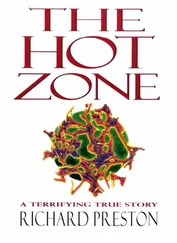Richard Preston
PANIC IN LEVEL 4
Cannibals, Killer Viruses, and Other Journeys to the Edge of Science
To my father,
Jerome Preston, Jr.
Considering the marvelous adventures
you took me on and sent me on,
this book seems inevitable.
Introduction: Adventures in Nonfiction Writing
OLIVER HEAVISIDE, the English mathematician and physicist, once said, “In order to know soup, it is not necessary to climb into a pot and be boiled.” Unfortunately, this statement is not true for journalists. As a writer of what’s called “literary nonfiction” or “creative nonfiction”—narrative that is said to read like a novel but is factually verifiable—it has often been my practice to climb into the soup. Getting boiled with your characters is a good way to get to know them, but it has occasionally led me into frightening situations.
Some years ago, while I was researching The Hot Zone, a book that focuses on the Ebola virus, I may have had a meeting with an unknown strain of Ebola. (A virus is an exceedingly small life-form, an infectious parasite that replicates inside living cells, using the cell’s own machinery to make more copies of itself.)
Ebola has now been classified into seven different known types. Though it has been studied for more than thirty years, Ebola is one of the least-understood viruses in nature. Scientists have been understandably reluctant to study Ebola too closely because it has on occasion killed those who tried to do so. The virus was first was noticed in 1976, when it surfaced in Yambuku, Zaire (now the Democratic Republic of Congo), near the Ebola River, where it sacked a Catholic mission hospital, killing most of the medical staff along with a number of patients and people the patients had came into contact with. Ebola spreads from one person to the next by direct contact with blood or secretions, including sweat. There is no evidence that it can spread among humans through the air, although there is some evidence that it may spread among monkeys this way. As a parasite, Ebola carries on its life cycle in some unidentified type of animal—Ebola’s natural host—that lives in certain unidentified habitats in equatorial Africa. Occasionally Ebola comes into contact with a person, and the virus makes what is known as a trans-species jump from its host into the human species.
When Ebola gets inside a human host, it causes the person’s immune system to vanish, and the person dies with hemorrhages coming from the body’s orifices. The most lethal strains of Ebola have been known to kill up to 95 percent of people who become infected with it. Ebola causes people to vomit masses of black blood with a distinctive “coffee grounds” appearance. Victims can have a bright red nosebleed, or epistaxis; it won’t stop. A spotty, bumpy rash spreads over the body, while small, starlike hemorrhages appear beneath the skin. An Ebola patient can have blood standing in droplets on the eyelids and running from the tear ducts down the face. Blood can flow from the nose, mouth, vagina, rectum. The testicles can become infected with Ebola and can swell up or be destroyed. Victims display signs of psychosis. They can develop endless hiccups. Rarely, in particularly severe cases of Ebola, the linings of the intestines and rectum may come off. Those membranes may be expelled through the anus in raglike pieces called casts, or the intestinal lining can emerge in the form of a sleeve, like a sock. When an Ebola patient expels a sleeve, it is known as throwing a tubular cast.
* * *
SOME OF THE ACTION in The Hot Zone takes place at Fort Detrick, an Army base in the rolling country along the eastern flank of the Appalachian Mountains in Maryland, an hour’s drive northwest of Washington, D.C. The Army’s Level 4 virus laboratories at Fort Detrick are clustered inside a large, nearly windowless building that sits near the eastern perimeter of the base. This building is the headquarters of the United States Army Medical Research Institute of Infectious Diseases, or USAMRIID—a facility that Army people often simply refer to as “the Institute.” While I was visiting USAMRIID, or the Institute, to interview various experts in Ebola, I began asking officials at the base for permission to put on a biohazard space suit and enter one of the Army’s Biosafety Level 4 virus laboratories. I wanted to get a firsthand look at researchers handling Ebola. More than that, I wanted to know what it feels like to wear a biohazard space suit and be face-to-face with a real Level 4 virus, so that I could get a sense of my characters’ feelings and experiences, and could describe them with convincing precision. (Many nonfiction writers refer to their characters as “subjects,” but I prefer to think of them as dramatis personae in a true story.)
Biosafety Level 4, also called BL-4 or Level 4, is the highest and tightest level of biosecurity in a laboratory. Laboratories rated at Biosafety Level 4 are the repositories of viruses called hot agents—lethal viruses for which there is no vaccine or effective cure. Level 4 labs are sealed off from the outside world. People who go inside a Level 4 lab are required to wear a biohazard space suit, a pressurized whole-body suit, like an astronaut’s, made of soft, flexible plastic, typically blue. Army researchers sometimes refer to the space suit as a “blue suit” because of its color. A soft, flexible helmet that completely surrounds the head is joined to the suit, and the helmet has a clear, flexible plastic faceplate in it; the suit also has an independent air supply. The air supply prevents you from breathing the air inside the lab, which could be contaminated with a hot agent. Ebola virus is classified as a Level 4 hot agent, one of the most dangerous known, and it has the potential to be used as a biological weapon. The scientists at USAMRIID (it’s pronounced “you-SAM-rid”) conduct research into vaccines and drugs that could be used to protect the population of the United States against a terrorist or military attack with a biological weapon, including Ebola virus. This is medical research, peaceful in nature.
The Level 4 labs inside the Institute consist of groups of interconnected rooms. Each group of rooms is known as a hot suite or a hot zone. Each suite is sealed off from the outside world and is accessible only through an air lock. The air lock has heavy, stainless steel doors. Inside the air lock there is a chemical decontamination shower, also known as a “decon” shower. The purpose of the decon shower is to sterilize the outer surface of the space suits of researchers who are leaving a hot zone, to prevent a hot agent from getting a ride to the outside world. Chest freezers inside the Army’s hot zones are filled with collections of microvials (tiny plastic test tubes the size of a pencil stub) that contain frozen or freeze-dried samples of many different strains of lethal viruses.
The freezers are kept at 95 degrees below zero Fahrenheit. They are said to be hot. They are hot in a biological sense: they contain frozen samples of lethal viruses that are held in suspended animation in the extreme cold. The virus collections stored in USAMRIID’s hot freezers are said to include strains of Bolivian hemorrhagic fever virus, Guanarito virus, Junín virus, dengue hemorrhagic fever, Venezuelan equine encephalitis (VEE), Japanese encephalitis virus (JEV), Hendra virus, Nipah virus, Lassa virus, and the seven known types of Ebola. (These viruses’ effects on humans vary. Guanarito, Junín, and Lassa, for example, cause hemorrhaging from the body’s orifices, like Ebola. VEE and JEV infect the brain and spinal cord, causing coma or death. Nipah is a brain virus from Malaysia that can trigger a literal meltdown of the brain. The brain of a Nipah victim can be semiliquefied as the virus consumes it, and can pour out of the skull during an autopsy.) The hot freezers also may contain (although the Army doesn’t say much about this) an assortment of Level 4 Unknown viruses, or X viruses. The Unknown X viruses appear to be lethal in humans, but little is known about them. They’ve never been fully studied or classified. They may include something known as the Linköping Samples, which may or may not harbor an unidentified type of Ebola. The X viruses are presumed to be potentially lethal, so they are kept in Level 4 for safety.
Читать дальше








![Shin_Stark - В подземелье я пойду, там свой level подниму X [СИ]](/books/384602/shin-stark-v-podzemele-ya-pojdu-tam-svoj-level-po-thumb.webp)



